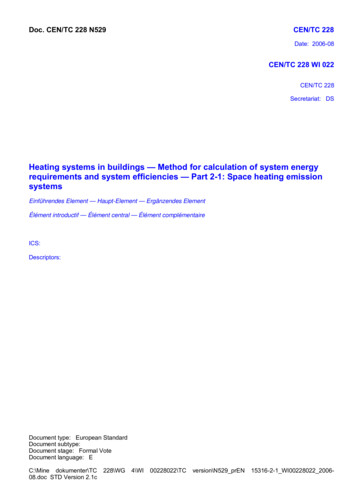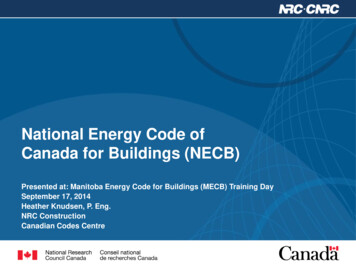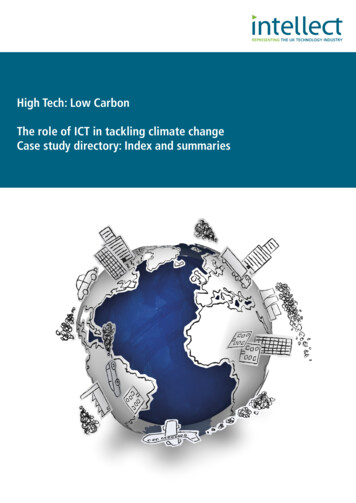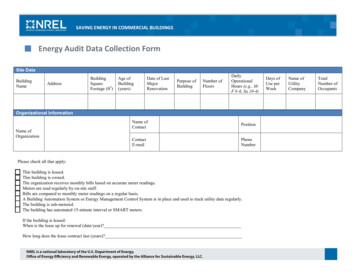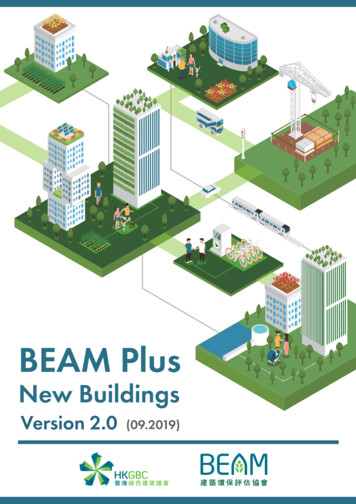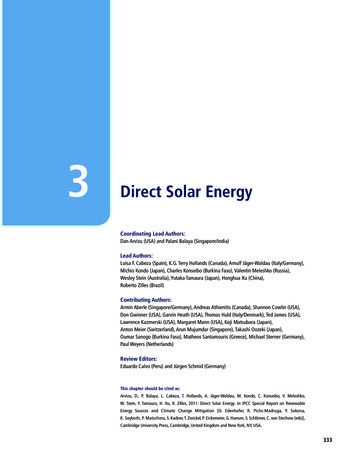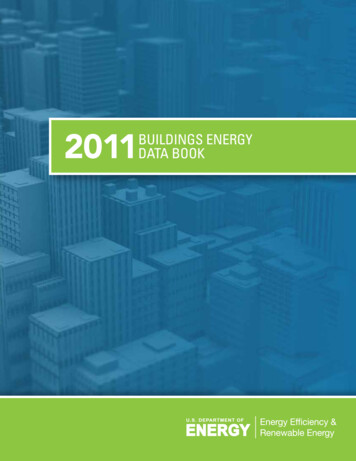
Transcription
2011 Buildings Energy Data BookMarch 2012Prepared for theBuildings Technologies ProgramEnergy Efficiency and Renewable EnergyU.S. Department of EnergybyD&R International, Ltd.under contract toPacific Northwest National Laboratory
This version is dated: March 2012This document was designed for the internal use of the United States Department of Energy. This documentwill be occasionally updated and, therefore, this copy may not reflect the most current version.This document was prepared as account of work sponsored by an agency of the United States Government.Neither the United States Government nor any agency thereof, nor any of their employees, makes anywarranty, express or implied, or assumes any legal liability or responsibility for the accuracy, completeness,or usefulness of any information, apparatus, product, or process disclosed, or represents that its use would notinfringe privately owned rights. Reference herein to any specific commercial product, process, or service bytrade name, trademark, manufacturer, or otherwise, does not necessarily constitute or imply its endorsement,recommendation, or favoring by the United States Government or any agency, contractor or subcontractorthereof. The views and opinions of authors expressed herein do not necessarily state or reflect those of theUnited States Government or any agency, contractor or subcontractor thereof.
Table of ContentsTable of Contents.Forward.Introduction.List of Table.Glossary.1.02.03.04.05.06.07.0Buildings Sector.1.1 Buildings Sector Energy Consumption.1.2 Building Sector Expenditures.1.3 Value of Construction and Research.1.4 Environmental Data.1.5 Generic Fuel Quad and Comparison.1.6 Embodied Energy of Building Assemblies.The Residential Sector.2.1 Residential Sector Energy Consumption.2.2 Residential Sector Characteristics.2.3 Residential Sector Expenditures.2.4 Residential Environmental Data.2.5 Residential Construction and Housing Market.2.6 Residential Home Improvements.2.7 Multi-Family Housing.2.8 Industrialized Housing.2.9 Low-Income Housing.Commercial Sector.3.1 Commercial Sector Energy Consumption.3.2 Commercial Sector Characteristics.3.3 Commercial Sector Expenditures.3.4 Commercial Environmental Emissions.3.5 Commercial Builders and Construction.3.6 Office Building Markets and Companies.3.7 Retail Markets and Companies.3.8 Hospitals and Medical Facilities.3.9 Educational Facilities.3.10 Hotels/Motels.Federal Sector.4.1 Federal Buildings Energy Consumption.4.2 Federal Buildings and Facilities Characteristics.4.3 Federal Buildings and Facilities Expenditures.4.4 Legislation Affecting Energy Consumption of Federal Buildings and Facilities.Envelope and Equipment.5.1 Building Materials/Insulation.5.2 Windows.5.3 Heating, Cooling, and Ventilation Equipment.5.4 Water Heaters.5.5 Thermal Distribution Systems.5.6 Lighting.5.7 Appliances.5.8 Active Solar Systems.5.9 On-Site Power.Energy Supply.6.1 Electric Utility Energy Consumption.6.2 Electricity Generation, Transmission, and Distribution.6.3 Natural Gas Production and Distribution.6.4 Electric and Generic Quad Carbon Emissions.6.5 Public Benefit Funds/System Benefit Funds.Laws, Energy Codes, and Standards.7.1 National Legislation.7.2 Federal Tax -147-17-17-6
Table of Contents8.09.07.3 Efficiency Standards for Residential HVAC.7.4 Efficiency Standards for Commercial HVAC.7.5 Efficiency Standards for Residential Appliances.7.6 Efficiency Standards for Lighting.7.7 Water Use Standards.7.8 State Building Energy Codes.Water.8.1 Buildings Sector Water Consumption.8.2 Residential Sector Water Consumption.8.3 Commercial Sector Water Consumption.8.4 WaterSense.8.5 Federal Government Water Usage.Market Transformation.9.1 ENERGY STAR.9.2 LEED.9.3 Certification Programs.9.4 High Performance 08-119-19-19-109-129-15
ForewordThe U.S. Department of Energy's (DOE) Office of Energy Efficiency and Renewable Energy hasdeveloped this Buildings Energy Data Book to provide a current and accurate set ofcomprehensive buildings-related data, and to promote the use of such data for consistencythroughout DOE programs.Data is organized into nine chapters; Chapter 1 – Buildings Sector, Chapter 2 – ResidentialSector, Chapter 3 – Commercial Sector, Chapter 4 – Federal Sector, Chapter 5 – Envelope andEquipment, Chapter 6– Energy Supply, Chapter 7 – Energy Codes, Standards, and Laws,Chapter 8 – Water Data, and Chapter 9 – Market Transformation. New data tables oncommercial building energy benchmarks were added to their relevant sections. New data tableswere also developed from an updated report on commercial refrigeration. You will also findupdated market transformation data from the ENERGY STAR program and the U.S. GreenBuilding Council. We continue to refine and provide water data.We hope you find the 2011 Buildings Energy Data Book useful. You are encouraged tocomment on errors, omissions, emphases, and organization of this report to the person listedbelow. Requests for additional copies of this report, additional data, or information on anexisting table should be referred to D&R International.Jordan D. Kelso, PED&R International, Ltd.1300 Spring StreetSuite 500Silver Spring, Maryland 20910Telephone: (301) 588-9387Fax: (301) 588-0854E-mail: jkelso@drintl.comThe 2010 Buildings Energy Data Book can be found on the web at:http://buildingsdatabook.eere.energy.gov/v
IntroductionThe 2010 Buildings Energy Data Book is a statistical compendium prepared and published undercontract with the Pacific Northwest National Laboratory (PNNL) with support from the U.S.Department of Energy’s Office of Energy Efficiency and Renewable Energy (EERE). PNNLfirst published the predecessor to the annual Buildings Energy Data Book in 1986. PNNLpublished these through 2004; Oak Ridge National Laboratory 2005-2006, and National EnergyTechnology Laboratory 2007-2009.The Department of Energy's Office of Energy Efficiency and Renewable Energy has developedthis 2010 Buildings Energy Data Book to provide a current and accurate set of comprehensivebuildings-related data and to promote the use of such data for consistency throughout DOEprograms. Additional data (e.g., more current, widely accepted, and/or better documented data)and suggested changes should be submitted to D&R International. Please provide full sourcereferences along with all data.The Buildings Energy Data Book is a compendium of data and does not provide original data.Much of the data gathered is from government documents, models, and analysis. All datasources are included with each data table.vi
List of Tables1.0Buildings Sector.1.1 Buildings Sector Energy Consumption.1.1.1 U.S. Residential and Commercial Buildings Total Primary Energy Consumption.1.1.2 U.S. Buildings Site Renewable Energy Consumption.1.1.3 Buildings Share of U.S. Primary Energy Consumption.1.1.4 2010 U.S. Buildings Energy End-Use Splits, by Fuel Type.1.1.5 2015 U.S. Buildings Energy End-Use Splits, by Fuel Type.1.1.6 2025 U.S. Buildings Energy End-Use Splits, by Fuel Type.1.1.7 2035 U.S. Buildings Energy End-Use Splits, by Fuel Type.1.1.8 Shares of U.S. Buildings Generic Quad.1.1.9 Buildings Share of U.S. Electricity Consumption.1.1.10 Buildings Share of U.S. Natural Gas Consumption.1.1.11 Buildings Share of U.S. Petroleum Consumption.1.1.12 Buildings Share of U.S. Petroleum Consumption.1.1.13 World Primary Energy Consumption and Population, by Country/Region.1.2 Building Sector Expenditures.1.2.1 Building Energy Prices, by Year and Major Fuel Type.1.2.2 Building Energy Prices, by Year and Fuel Type.1.2.3 Buildings Aggregate Energy Expenditures, by Year and Major Fuel Type.1.2.4 FY 2005 Federal Buildings Energy Prices' and Expenditures, by Fuel Type.1.2.5 2010 Buildings Energy End-Use Expenditure Splits, by Fuel Type.1.2.6 2015 Buildings Energy End-Use Expenditure Splits, by Fuel Type.1.2.7 2025 Buildings Energy End-Use Expenditure Splits, by Fuel Type.1.2.8 2035 Buildings Energy End-Use Expenditure Splits, by Fuel Type.1.2.9 Implicit Price Deflators.1.3 Value of Construction and Research.1.3.1 Estimated Value of All U.S. Construction Relative to the GDP.1.3.2 Value of New Building Construction Relative to GDP, by Year.1.3.3 Value of Building Improvements and Repairs Relative to GDP, by Year.1.3.4 2003 U.S. Private Investment into Construction R&D.1.3.5 International Investment into Construction and Energy R&D 2007-2010 Investment into Constructionand Energy R&D, by Selected Country.1.3.6 FY2003-2005 Green Building R&D, as Share of Federal Budget and by Organization.1.3.7 Buildings Design and Construction Trades, by Year.1.3.8 Number of Construction Employees and Total Employees for Select Industries (Building Envelope).1.3.9 Number of Construction Employees and Total Employees for Select Industries (Building Equipment).1.4 Environmental Data.1.4.1 Carbon Dioxide Emissions for U.S. Buildings, by Year.1.4.2 2010 Buildings Energy End-Use Carbon Dioxide Emissions Splits, by Fuel Type.1.4.3 2015 Buildings Energy End-Use Carbon Dioxide Emissions Splits, by Fuel Type.1.4.4 2025 Buildings Energy End-Use Carbon Dioxide Emissions Splits, by Fuel Type.1.4.5 2035 Buildings Energy End-Use Carbon Dioxide Emissions Splits, by Fuel Type.1.4.6 World Carbon Dioxide Emissions.1.4.7 2009 Methane Emissions for U.S. Buildings Energy Production, by Fuel Type.1.4.8 2010 Carbon Dioxide Emission Coefficients for Buildings.1.4.9 Average Carbon Dioxide Emissions from a Generic Quad in the Buildings Sector with Stock FuelMix and Projected Fuel Mix of New Marginal Utility Capacity and Site Energy Consumption(Million Metric Tons) (1).1.4.10 2010 Emissions Summary Table for U.S. Buildings Energy Consumption (Thousand Short Tons) (1).1.4.11 EPA Criteria Pollutant Emissions Coefficients.1.4.12 Characteristics of U.S. Construction Waste.1.4.13 "Typical" Construction Waste Estimated for a 2,000-Square-Foot Home.1.4.14 2003 Construction and Demolition Debris Generated from Construction Activities.1.4.15 Disposal and Recovery of Construction and Demolition (C&D) Materials in 2003.1.5 Generic Fuel Quad and Comparison.1.5.1 Key Definitions.1.5.2 Consumption Comparisons in 2005.1.5.3 Carbon Emission -291-291-291-30
List of Tables2.01.5.4 Average Annual Carbon Dioxide Emissions for Various Functions.1.5.5 Cost of a Generic Quad Used in the Buildings Sector.1.5.6 Shares of U.S. Buildings Generic Quad.1.6 Embodied Energy of Building Assemblies.1.6.1 Embodied Energy of Commercial Windows in the U.S.1.6.2 Embodied Energy of Commercial Studded Exterior Walls in the U.S.1.6.3 Embodied Energy of Commercial Concrete Exterior Walls in the U.S.1.6.4 Embodied Energy of Commercial Wood-Based Roof Assemblies in the U.S.1.6.5 Embodied Energy of Other Commercial Roof Assemblies in the U.S.1.6.6 Embodied Energy of Commercial Interior Wall Assemblies in the U.S.1.6.7 Embodied Energy of Commercial Floor Structures in the U.S.1.6.8 Embodied Energy of Commercial Column and Beam Assemblies in the U.S.The Residential Sector.2.1 Residential Sector Energy Consumption.2.1.1 Residential Primary Energy Consumption, by Year and Fuel Type.2.1.2 Shares of U.S. Residential Buildings Generic Quad.2.1.3 Residential Site Renewable Energy Consumption.2.1.4 Residential Delivered and Primary Energy Consumption Intensities, by Year.2.1.5 2010 Residential Energy End-Use Splits, by Fuel Type.2.1.6 2015 Residential Energy End-Use Splits, by Fuel Type.2.1.7 2025 Residential Energy End-Use Splits, by Fuel Type.2.1.8 2035 Residential Energy End-Use Splits, by Fuel Type.2.1.9 2005 Delivered Energy End-Uses for an Average Household, by Region.2.1.10 2005 Residential Delivered Energy Consumption Intensities, by Census Region.2.1.11 2005 Residential Delivered Energy Consumption Intensities, by Housing Type.2.1.12 2005 Residential Delivered Energy Consumption Intensities, by Vintage.2.1.13 1997 Residential Delivered Energy Consumption Intensities, by Principal Building Type and Vintage.2.1.14 1997 Residential Delivered Energy Consumption Intensities, by Ownership of Unit.2.1.15 Aggregate Residential Building Component Loads as of 1998.2.1.16 Operating Characteristics of Electric Appliances in the Residential Sector.2.1.17 Operating Characteristics of Natural Gas Appliances in the Residential Sector.2.1.18 Annual Gas Consumption per Appliance by Region.2.1.19 Residential Buildings Share of U.S. Natural Gas Consumption (Percent) .2.1.20 Residential Buildings Share of U.S. Petroleum Consumption (Percent) .2.2 Residential Sector Characteristics.
2010 Buildings Energy Data Book to provide a current and accurate set of comprehensive buildings-related data and to promote the use of such data for consistency throughout DOE programs. Additional data (e.g., more current, widely accepted, and/or better documented data) and suggested changes should be submitted to D&R International.
